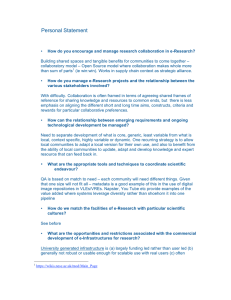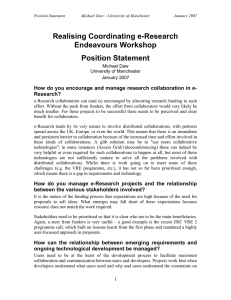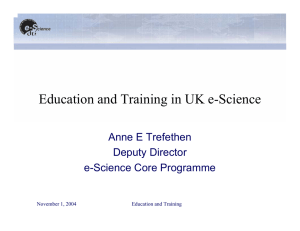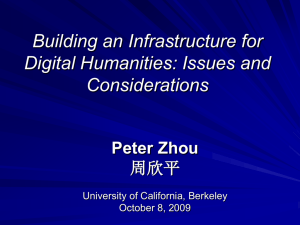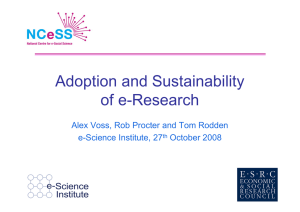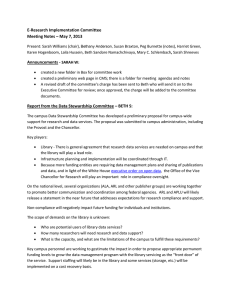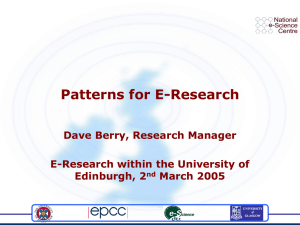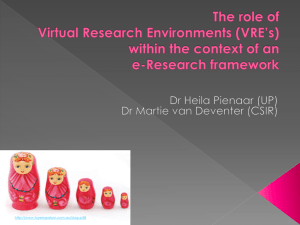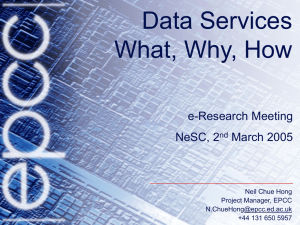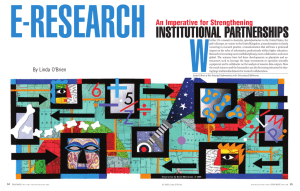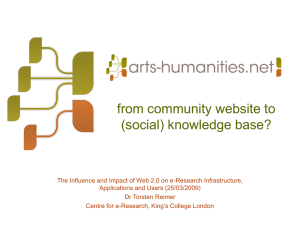Managing User-Designer Relations in e-Research Projects
advertisement
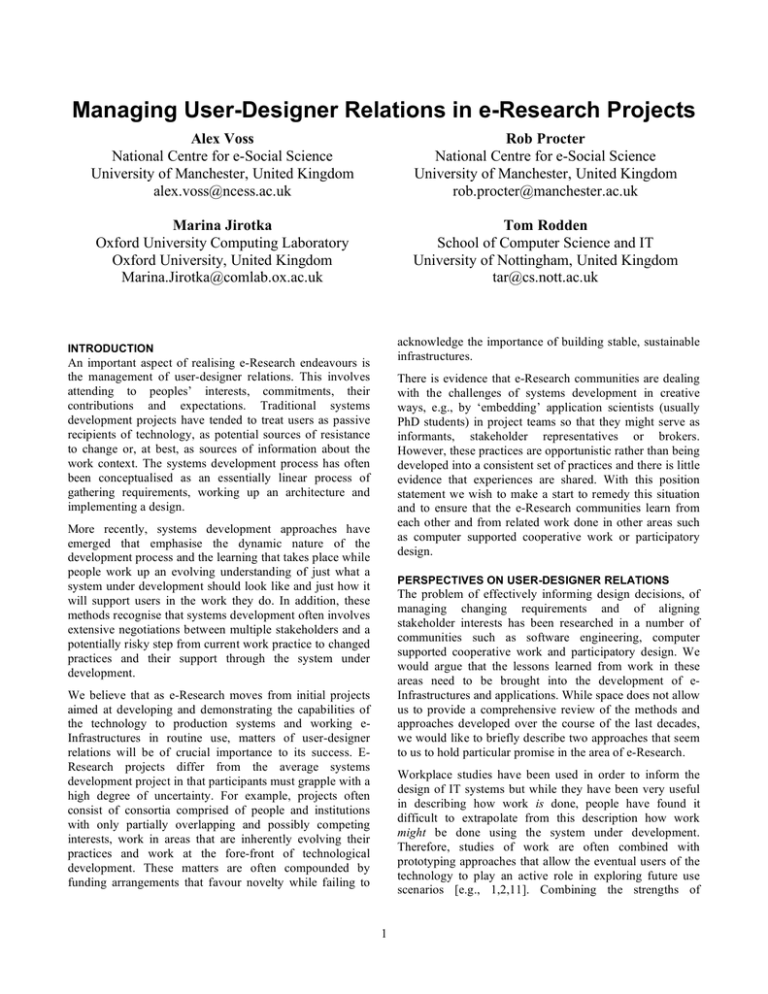
Managing User-Designer Relations in e-Research Projects Alex Voss National Centre for e-Social Science University of Manchester, United Kingdom alex.voss@ncess.ac.uk Rob Procter National Centre for e-Social Science University of Manchester, United Kingdom rob.procter@manchester.ac.uk Marina Jirotka Oxford University Computing Laboratory Oxford University, United Kingdom Marina.Jirotka@comlab.ox.ac.uk Tom Rodden School of Computer Science and IT University of Nottingham, United Kingdom tar@cs.nott.ac.uk acknowledge the importance of building stable, sustainable infrastructures. INTRODUCTION An important aspect of realising e-Research endeavours is the management of user-designer relations. This involves attending to peoples’ interests, commitments, their contributions and expectations. Traditional systems development projects have tended to treat users as passive recipients of technology, as potential sources of resistance to change or, at best, as sources of information about the work context. The systems development process has often been conceptualised as an essentially linear process of gathering requirements, working up an architecture and implementing a design. There is evidence that e-Research communities are dealing with the challenges of systems development in creative ways, e.g., by ‘embedding’ application scientists (usually PhD students) in project teams so that they might serve as informants, stakeholder representatives or brokers. However, these practices are opportunistic rather than being developed into a consistent set of practices and there is little evidence that experiences are shared. With this position statement we wish to make a start to remedy this situation and to ensure that the e-Research communities learn from each other and from related work done in other areas such as computer supported cooperative work or participatory design. More recently, systems development approaches have emerged that emphasise the dynamic nature of the development process and the learning that takes place while people work up an evolving understanding of just what a system under development should look like and just how it will support users in the work they do. In addition, these methods recognise that systems development often involves extensive negotiations between multiple stakeholders and a potentially risky step from current work practice to changed practices and their support through the system under development. PERSPECTIVES ON USER-DESIGNER RELATIONS The problem of effectively informing design decisions, of managing changing requirements and of aligning stakeholder interests has been researched in a number of communities such as software engineering, computer supported cooperative work and participatory design. We would argue that the lessons learned from work in these areas need to be brought into the development of eInfrastructures and applications. While space does not allow us to provide a comprehensive review of the methods and approaches developed over the course of the last decades, we would like to briefly describe two approaches that seem to us to hold particular promise in the area of e-Research. We believe that as e-Research moves from initial projects aimed at developing and demonstrating the capabilities of the technology to production systems and working eInfrastructures in routine use, matters of user-designer relations will be of crucial importance to its success. EResearch projects differ from the average systems development project in that participants must grapple with a high degree of uncertainty. For example, projects often consist of consortia comprised of people and institutions with only partially overlapping and possibly competing interests, work in areas that are inherently evolving their practices and work at the fore-front of technological development. These matters are often compounded by funding arrangements that favour novelty while failing to Workplace studies have been used in order to inform the design of IT systems but while they have been very useful in describing how work is done, people have found it difficult to extrapolate from this description how work might be done using the system under development. Therefore, studies of work are often combined with prototyping approaches that allow the eventual users of the technology to play an active role in exploring future use scenarios [e.g., 1,2,11]. Combining the strengths of 1 observational methods with active exploration of future use and prototyping allows the development process to be responsive to peoples’ evolving understanding of their work and how it might change and to ensure participation while at the same time placing no undue demands on participants. The explicit resourcing of a role that mediates between design and use can help ensure that issues of usability and usefulness are not sidelined in the project. While workplace studies aim to bridge the gap between design and use by making information about work practice available to designers and prototyping aims to bring users into the design process more strongly, a third approach involves attempting to resolve the distinction between design and use altogether by locating design activities in the workplace and making them part and parcel of what work in the setting involves. Corealisation [4,9] has been developed as an orientation to design work as an activity that is located in the unfolding biography of a setting by making designers normal members of the workplace, thus allowing design work to be informed by observations made through everyday contact with the users and their work environment as well as making design work accountable to users. An important aspect of corealisation is that it does not try to bridge the gap between design and use by introducing an intermediary such as a social science researcher to inform design but instead calls on the designers to become familiar with work practices through their own observations of and interactions with users and their work. Although middleware and infrastructure developers are becoming much more sensitive to users’ needs [cf. 7] and are actively seeking feedback on usability, one has only to look at the organisation and technical complexities of managing digital certificates for eScience to realise just how much skill and effort is involved in developing and operating workable and stable applications and work environments. Design choices are constrained by the centrally provided services, for example, NGS are currently using version 2 of the Globus Toolkit middleware stack while other resources are likely to be provided through web services based mechanisms using GT version 4 and other middleware stacks. Having to manage multiple only partially compatible versions of the middleware makes a mockery of the vision of grid technologies as a layer that would allow access to heterogeneous resources to be provided in a unified way [cf. 8]. Another important aspect of the development of a research environment is the provision of adequate interfaces to the basic tools that are currently provided by grid einfrastructures - data management and compute services. Because of the diverse range of researchers’ backgrounds and practices these interfaces have to be designed to be flexible enough to suit different needs. While some researchers might be familiar with command-line tools and scripting languages and able to use the native interfaces provided by the services, others will require a simpler interface tailored to their specific needs. Finding ways of providing different kinds of interfaces remains a challenge in the face of scarce resources. E-RESEARCH CHALLENGES We have noted above that e-Research endeavours differ in significant ways from other IT projects in that they deal with significant and inherent uncertainties. Issues of trust in technologies, in collaboration partners, in data collected, its provenance, the methods used to process it and the repeatability of findings are of crucial importance if eResearch is to become an accepted part of scientific practice. It is therefore of crucial importance to engender mutual understanding about the relationship between the design of applications and scientific practice and to establish very clearly what can reasonably be expected of the technology and of particular projects so as to ensure that the hype around e-Research does not lead to frustrations on the side of scientific partners when they confront the realities of the state of play in technology development[cf. 3,10]. Projects like Integrative Biology (IB) [6] and the Integrative Biology Virtual Research Environment project (IBVRE) [ibid.] also highlight important issues about the divisions of labour amongst the technology developers. The aim of the IB project, for example, is to develop an infrastructure for multi-scale modelling of heart function and of cancer using existing infrastructures such as the National Grid Service. This means that the IB developers, in many respects, are the users of a technology that has been imposed upon them. APPROACHES We feel that despite the challenges mentioned above, the underlying infrastructure of basic services and middleware components is maturing and experience with their use gets increasingly embedded in research organisations (although there is still a shortage of skilled developers compounded by the traditional reliance on fixed-term staff and PhD students). There is an opportunity to move away from the ‘string and sealing wax’ prototypes of the early days and to work towards the realisation of working virtual research environments that are composed of established building blocks. As the effort involved in making the basic technological components work is reduced more and more, there is a chance to invest more effort into understanding the real-world requirements that application researchers have and to translate that understanding into VREs that are uniquely adequate and kept in alignment with evolving research practices. Projects such as IBVRE [6] have already made use of the affordances of Grid services to rapidly assemble working prototypes on site after an initial short period of observation of scientific practice. This allowed users to get involved in the design and development through incremental delivery and the use of working prototypes early on in the design process, which increased their sense of ownership of the system under development. Hosting a pilot at the end user institution also helped to increase users sense of control over the system being developed. In addition, where challenges to usability were foreseen, IB allocated analysts to shepherd users through the complexities of securing access. It is likely that for some time yet, such extra support will be required to get people over the initial hurdles involved in adopting e-infrastructures. project. From Grid to Healthgrid - Proceedings of Healthgrid, IOS Press, 2005, pp. 198-209. 4. Hartswood, M., Procter, R., Slack, R., Voß, A., Buscher, M., Rouncefield, M., Rouchy, P. Co-realisation: Towards a Principled Synthesis of Ethnomethodology and Participatory Design. Scandinavian Journal of Information Systems, 14(2), 2002. pp. 9-30. 5. Jirotka, M., Procter, R., Hartswood, M., Slack, R., Simpson, A., Coopmans, C., Hinds, C. and Voss, A. Collaboration and Trust in Healthcare Innovation: The eDiaMoND Case Study. Computer Supported Cooperative Work 14(4), 2005. pp. 369-398. CONCLUSIONS We believe that the approaches outlined above are particularly useful in an e-Research context which involves a complex and evolving set of practices that makes it crucial not only to elicit requirements in a one-off process but to ensure that infrastructures and applications are kept in alignment with evolving needs. Depending on the particular context, ethnographic observation, prototyping, corealisation and other methods can play a role in realising e-Research endeavours and managing the user-designer relationship. While there cannot be a single silber bullet approach that applies in all situations, existing work provides a set of tools and orientations that can be applied in combination to help delivering support for e-Research in a more routine way satisfying the needs of researchers and their projects. 6. Lloyd, S. et al. Integrative Biology – the challenges of developing a collaborative research environment for heart and cancer modelling. Future Generation Computer Systems 23, 2007. pp. 457-465. 7. Newhouse, S., Schopf, J., Richards, A. and Atkinson, M. Study of User Priorities for e-Research (SUPER). Draft report, 13th January 2007. 8. Sloot, P. et al. White paper on Computational e-Science: Studying complex systems in silico. A National Research Initiative. December 2006. 9. Voss, A. Corealisation: A Radical Respecification of the Working Division of Labour in Systems Development. PhD Thesis, School of Informatics, University of Edinburgh, 2007. REFERENCES 1. Blomberg, J., Suchman, L. and Trigg, R. Working Artifacts: Ethnomethods of the Prototype. British Journal of Sociology 53(2), 2002. pp. 163-179. 10. Warr, A., de la Flor, G., Jirotka, M. and Lloyd, S. Usability in e-Science: The eDiaMoND Case Study. accepted for CHI 2007 workshop ‘Increasing the impact of usability work in software development’. 2. Büscher, M., Christensen, M., Hansen, M., Mogensen, P. and Shapiro, D. Bottom-up, top-down? Connecting software architecture design with use. In: Voss, A., Hartswood, M., Ho, K., Procter, R., Rouncefield, M., Slack, R. and Büscher, M. (eds.) Configuring userdesigner relations: Interdisciplinary perspectives. Springer (forthcoming) 11. Yeh, R., Liao, C. Klemmer, S., Guimbretière, F., Lee, B., Kakaradov, B., Stamberfer, J. and Paepcke, A. ButterflyNet: A Mobile Capture and Access System for Field Biology Research. Proceedings of the Conference on Human Factors in Computer Systems. Montréal, April 2006. pp. 571-580. 3. Hartswood, M., Jirotka, M., Procter, R., Slack, R., Voss, A. and Lloyd, S. Working IT out in e-Science: Experiences of requirements capture in a HealthGrid 3
